Energy and Seismic Recovering of Ancient Hamlets: the Case of Baia e Latina
Abstract
:1. Introduction
- Benedetti–Petrini Seismic Vulnerability Assessment of all of the analysed urban sections [10];
- processing CARTIS sheets for the detection of the prevailing building typologies within sub-communal areas, characterized by the building homogeneity for age and/or construction and structural techniques (Figure 1);
- energy diagnosis of the points of strength (potentialities) and weakness (problems) of every building of the analysed urban section;
- identification of architectural and technological solutions that are necessary in order to improve energy performances [11];
- evaluation of the positive and cumulative benefit of each intervention, after a sensitivity analysis that matches the security needs with the minimum requirements imposed by L.90/2013.
2. Technological Retrofit Design for the Energy Improvements
2.1. The Methodological Approach
2.2. The Case Study: Technology Analysis and Energy Optimisation
- (1)
- dispersions (both horizontal and vertical) from external walls towards unheated rooms, rooms with different temperatures, and the outdoor environment;
- (2)
- dispersions from the transparent components (windows) towards the outdoor environment;
- (3)
- free heating provisions: solar provisions and from indoor emissions.
- -
- comply with the limits imposed by the Implementing Decrees of Law 90/2013 (of 26 June 2015), Appendix B, regarding the thermal transmittance requirements for opaque and transparent components;
- -
- comply with the limits imposed by Presidential Decree 59/2009 for periodic thermal transmittance, and limit energy requirements for cooling, in order to ensure summer comfort;
- -
- verify the equivalent solar area (solar radiation control on transparent envelope);
- -
- verify and, where possible, encourage natural ventilation.
3. Analysis Criteria for Seismic Vulnerability and Damage Assessment of Historical Centres
- -
- μD is the mean damage grade;
- -
- Q is the ductility factor, equal to 2.3;
- -
- S is the macroseismic intensity, calculated on the basis of both the earthquake magnitude and the epicentre distance according to a given attenuation law [33];
- -
- VI is the normalized vulnerability index, framed within the range [0–1], that can be achieved from the IV,I one through the procedure specified in Formisano et al. [30].
4. The Case Study of Baia e Latina: Guidelines for a Sustainable Plan Action
4.1. Historical and Geographic News
4.2. Vulnerability, Damage Analysis, and Seismic Retrofitting
- -
- green for D1 damage condition (no damage) with 0 < μD ≤ 0.2;
- -
- blue for D2 damage condition (moderate damage) with 0.2 < μD ≤ 0.4;
- -
- yellow for D3 damage condition (intense damage) with 0.4 < μD ≤ 0.6;
- -
- magenta for D4 damage condition (extended damage) with 0.6 < μD ≤ 0.8; and
- -
- red for D5 damage condition (collapse) with 0.8 < μD ≤ 1.
- -
- planning and management of emergency response in the municipal area;
- -
- definition of municipal-wide thematic charts where, depending on the magnitude and the epicentre distance, it is possible to program certain interventions according to the damages scenarios;
- -
- location of interventions in the drafting of urban planning tools for the improvement of the quality of the existing building stock;
- -
- enhancement of infrastructure and services on the ground, depending on their vulnerability;
- -
- development of an integrated energy–seismic retrofit programme for urban habitats [39].
5. Conclusions
Author Contributions
Funding
Acknowledgments
Conflicts of Interest
References
- Fumo, M. Tempo ed efficienza funzionale in rapporto alle tecniche costruttive. In Materiali e Tecniche per il Recupero Edilizio; Luciano Editore: Napoli, Italy, 2005. [Google Scholar]
- Nardi, I.; de Rubeis, T.; Buzzi, E.; Sfarra, S.; Ambrosini, D.; Paoletti, D. Modeling and Optimization of the Thermal Performance of a Wood-Cement Block in a Low-Energy House Construction. Energies 2016, 9, 677. [Google Scholar] [CrossRef]
- La Greca, P.; Margani, G. Seismic and Energy Renovation Measures for Sustainable Cities: A Critical Analysis of the Italian Scenario. Sustainability 2018, 10, 254. [Google Scholar] [CrossRef]
- Marini, A.; Passoni, C.; Belleri, A.; Feroldi, F.; Preti, M.; Metelli, G.; Riva, P.; Giuriani, E.; Plizzari, G. Combining seismic retrofit with energy refurbishment for the sustainable renovation of RC buildings: A proof of concept. Eur. J. Environ. Civ. Eng. 2017. [Google Scholar] [CrossRef]
- Lamperti Tornaghi, M.; Loli, A.; Negro, P. Balanced Evaluation of Structural and Environmental Performances in Building Design. Buildings 2018, 8, 52. [Google Scholar] [CrossRef]
- Caruso, M.C.; Lamperti Tornaghi, M.; Negro, P. Applicability of the Sustainable Structural Design (SSD) method at urban/regional/national level. JRC Tech. Rep. 2017, 1–98. [Google Scholar] [CrossRef]
- Calvi, G.M.; Sousa, L.; Ruggeri, C. Energy Efficiency and Seismic Resilience: A Common Approach. In Multi-hazard Approaches to Civil Infrastructure Engineering; Springer International Publishing: Cham, Switzerland, 2016; pp. 165–208. [Google Scholar]
- Fumo, M. (Ed.) Materiali e Tecniche per il Recupero Edilizio; Luciano Editore: Napoli, Italy, 2005. [Google Scholar]
- Violano, A. Pro.D.I.S.E.: Un Protocollo per il patrimonio edilizio scolastico di Monte di Procida. TECHNE 2012, 3, 332–333. [Google Scholar] [CrossRef]
- Benedetti, D.; Petrini, V. On the seismic vulnerability of masonry buildings: An evaluation method (in Italian). L’Industria delle Costruzioni 1984, 149, 66–74. [Google Scholar]
- Franchino, R.; Violano, A. Energy, Environment and Safety: Technological retrofit of training buildings. HoPUE 2015, 3, 45–62. [Google Scholar]
- Ascione, F.; de Rossi, F.; Vanoli, G.P. Energy retrofit of historical buildings: Theoretical and experimental investigations for the modelling of reliable performance scenarios. Energy Build. 2011, 43, 1925–1936. [Google Scholar] [CrossRef]
- Carillo, S.; Muzzillo, F.; Violano, A. Contesti Minori di pregio. In Problemi di Conservazione ed eco-compatibilità/Less Noteworthy Contexts. Issues of Conservation and Eco-Compatibility; La Scuola di Pitagora Editore: Napoli, Italy, 2011. [Google Scholar]
- Cerroni, F. Progettare il Costruito: Tecnologie per la Riqualificazione Sostenibile dei Siti ad Elevata Qualità Storica e Ambientale; Gangemi Editore: Napoli, Italy, 2010; ISBN 9788849218268. [Google Scholar]
- Tubi, N.; Silva, M.P.; Ditri, F. Gli Edifici in Pietra; Sistemi Editoriali: Pozzuoli, Italy, 2009. [Google Scholar]
- Loli, A.; Bertolin, C. Towards Zero-Emission Refurbishment of Historic Buildings: A Literature Review. Buildings 2018, 8, 22. [Google Scholar] [CrossRef]
- Barthelmes, V.M.; Becchio, C.; Bottero, M.C.; Corgnati, S.P. The Influence of Energy Targets and Economic Concerns in Design Strategies for a Residential Nearly-Zero Energy Building. Buildings 2014, 4, 937–962. [Google Scholar] [CrossRef]
- Shilei, L.; Yong, W. Target-oriented obstacle analysis by PESTEL modeling of energy efficiency retrofit for existing residential buildings in China’s northern heating region. Energy Police 2009, 37, 2098–2101. [Google Scholar] [CrossRef]
- Benedetti, D.; Benzoni, G.; Parisi, M.A. Seismic vulnerability and risk evaluation for old urban nuclei. Earthq. Eng. Struct. Dynam. 1988, 16, 183–201. [Google Scholar] [CrossRef]
- Campostrini, G.P.; Taffarel, S.; Bettiol, G.; Valluzzi, M.R.; Da Porto, F.; Modena, C. A Bayesian approach to rapid seismic vulnerability assessment at urban scale. Int. J. Archit. Herit. 2018, 12, 36–46. [Google Scholar] [CrossRef]
- Formisano, A. Theoretical and Numerical Seismic Analysis of Masonry Building Aggregates: Case Studies in San Pio Delle Camere (L’Aquila, Italy). J. Earthq. Eng. 2017, 21, 227–245. [Google Scholar] [CrossRef]
- Giovinazzi, S.; Lagomarsino, S. Macroseismic and Mechanical Models for the Vulnerability Assessment of Current Buildings. Bull. Earthq. Eng. 2006, 4, 415–443. [Google Scholar]
- Giuffre, A. (Ed.) Safety and Conservation of Historical Centers: The Ortigia Case; Laterza Editor: Rome, Bari, Italy, 1993. (In Italian) [Google Scholar]
- Maio, R.; Vicente, R.; Formisano, A.; Varum, H. Seismic vulnerability of building aggregates through hybrid and indirect assessment techniques. Bull. Earthq. Eng. 2015, 13, 2995–3014. [Google Scholar] [CrossRef]
- Ramos, L.F.; Lourenço, P.B. Modeling and vulnerability of historical city centers in seismic areas: A case study in Lisbon. Eng. Struct. 2004, 26, 1295–1310. [Google Scholar] [CrossRef] [Green Version]
- Senaldi, I.; Magenes, G.; Penna, A. Numerical investigations on the Seismic Response of Masonry Building Aggregates. Adv. Mater. Res. 2010, 133, 715–720. [Google Scholar] [CrossRef]
- Italian National Group of Defence against Earthquake (GNDT). GNDT-INGV II Level Form for Masonry Buildings; Department of Civil Protection: Rome, 2010. (In Italian)
- Italian National Group of Defence against Earthquake (GNDT). GNDT-INGV II Level Form for Reinforced Concrete Buildings; Department of Civil Protection: Rome, 2010. (In Italian)
- Formisano, A.; Mazzolani, F.M.; Florio, G.; Landolfo, R. A quick methodology for seismic vulnerability assessment of historical masonry aggregates. In Proceedings of the COST Action C26 Final Conference “Urban Habitat Constructions under Catastrophic Events”, Naples, Italy, 16–18 September 2010; pp. 577–582. [Google Scholar]
- Formisano, A.; Florio, G.; Landolfo, R.; Mazzolani, F.M. Numerical calibration of an easy method for seismic behaviour assessment on large scale of masonry building aggregates. Adv. Eng. Softw. 2015, 80, 116–138. [Google Scholar] [CrossRef]
- S.T.A. DATA. 3MURI. Seismic Calculation of Masonry Structures According to M.D. 14/01/2008. New Technical Codes for Constructions. 2009. Available online: http://www.stadata.com/ (accessed on 8 August 2018).
- Giovinazzi, S.; Lagomarsino, S. A macroseismic method for the vulnerability assessment of buildings. In Proceedings of the 13th World Conference on Earthquake Engineering, Vancouver, BC, Canada, 1–6 August 2004. Paper No. 896. [Google Scholar]
- Sabetta, F.; Pugliese, A. Attenuation of peak horizontal acceleration and velocity from Italian strong motion records. Bull. Seism. Soc. Am. 1987, 77, 1491–1513. [Google Scholar]
- Formisano, A.; Chieffo, N.; Milo, B.; Fabbrocino, F. The influence of Local Mechanisms on Large Scale Seismic Vulnerability Estimation of Masonry Building Aggregates. In Proceedings of the 12th International Conference of Computational Methods in Sciences and Engineering (ICCMSE 2016), Athens, Greece, 7–20 March 2016; pp. 130010-1–130010-4. [Google Scholar]
- Grünthal, G. (Ed.) European Macroseismic Scale 1998 (EMS-98). In Cahiers du Centre Européen de Géodynamique et de Séismologie 15; Centre Européen de Géodynamique et de Séismologie: Walferdange, Luxembourg, 1998; p. 99. [Google Scholar]
- Formisano, A.; Chieffo, N.; Mosoarca, M. Seismic vulnerability and damage speedy estimation of an urban sector within the municipality of San Potito Sannitico (Caserta, Italy). Open Civ. Eng. J. 2017, 11, 1106–1121. [Google Scholar] [CrossRef]
- Formisano, A.; Chieffo, N.; Fabbrocino, F.; Landolfo, R. Seismic vulnerability and damage of Italian historical centres: A case study in the Campania region. AIP Conf. Proc. 2017, 1863. [Google Scholar] [CrossRef]
- Fumo, M.; Castelluccio, R.; Vigliotti, R.; D’Aniello, C. Analysis of post-earthquake interventions: Irpinia 80s and bradisism of Pozzuoli. In Colloqui.AT.e 2017. Demolition or Reconstruction? Bernardini, G., Di Giuseppe, E., Eds.; Edicom Edizioni: Monfalcone, Italy, 2017; ISBN 978-88-96386-57-6. [Google Scholar]
- Mauro, G.M.; Menna, C.; Vitiello, U.; Asprone, D.; Ascione, F.; Bianco, N.; Prota, A.; Vanoli, G.P. A Multi-Step Approach to Assess the Lifecycle Economic Impact of Seismic Risk on Optimal Energy Retrofit. Sustainability 2017, 9, 989. [Google Scholar] [CrossRef]
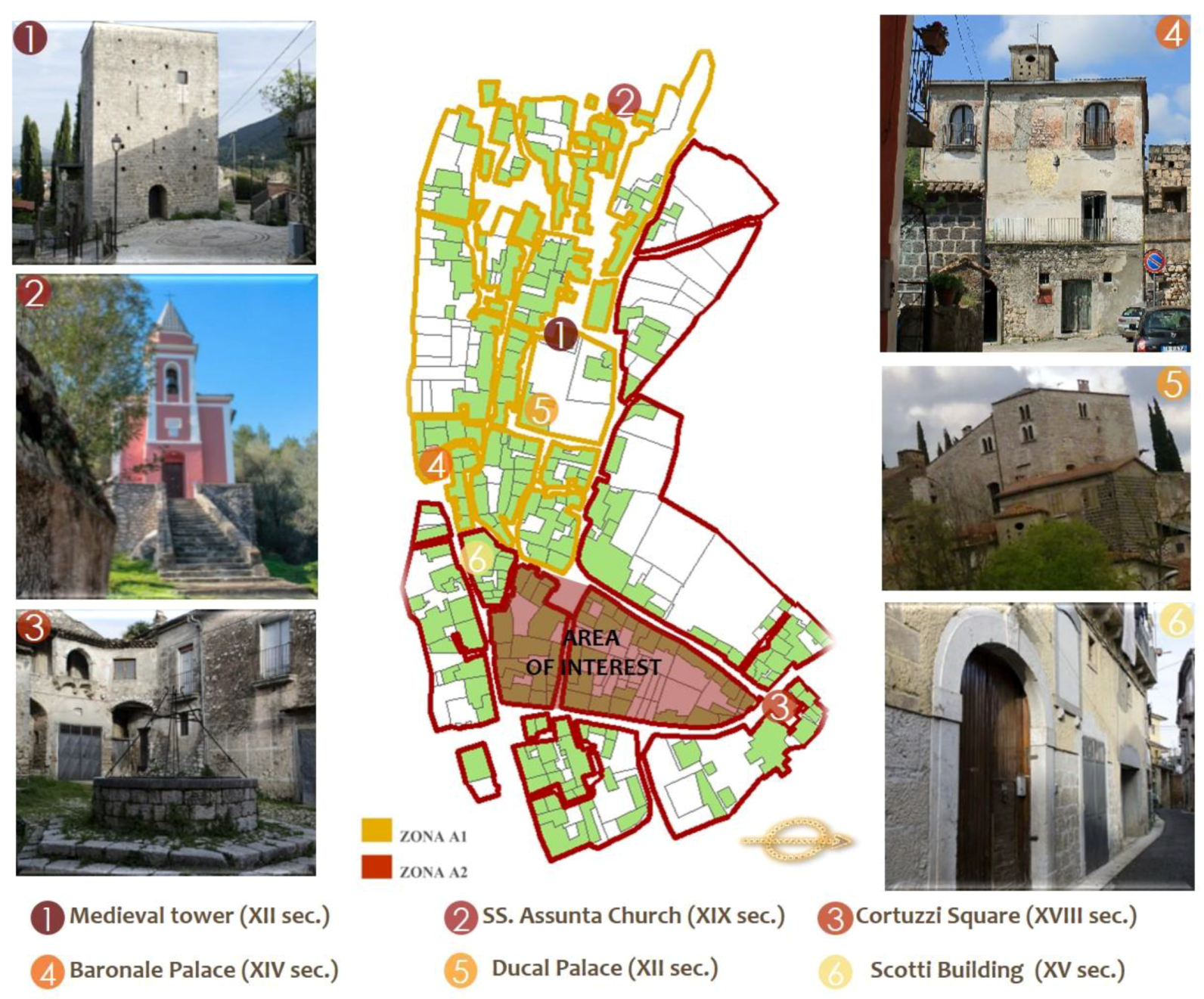


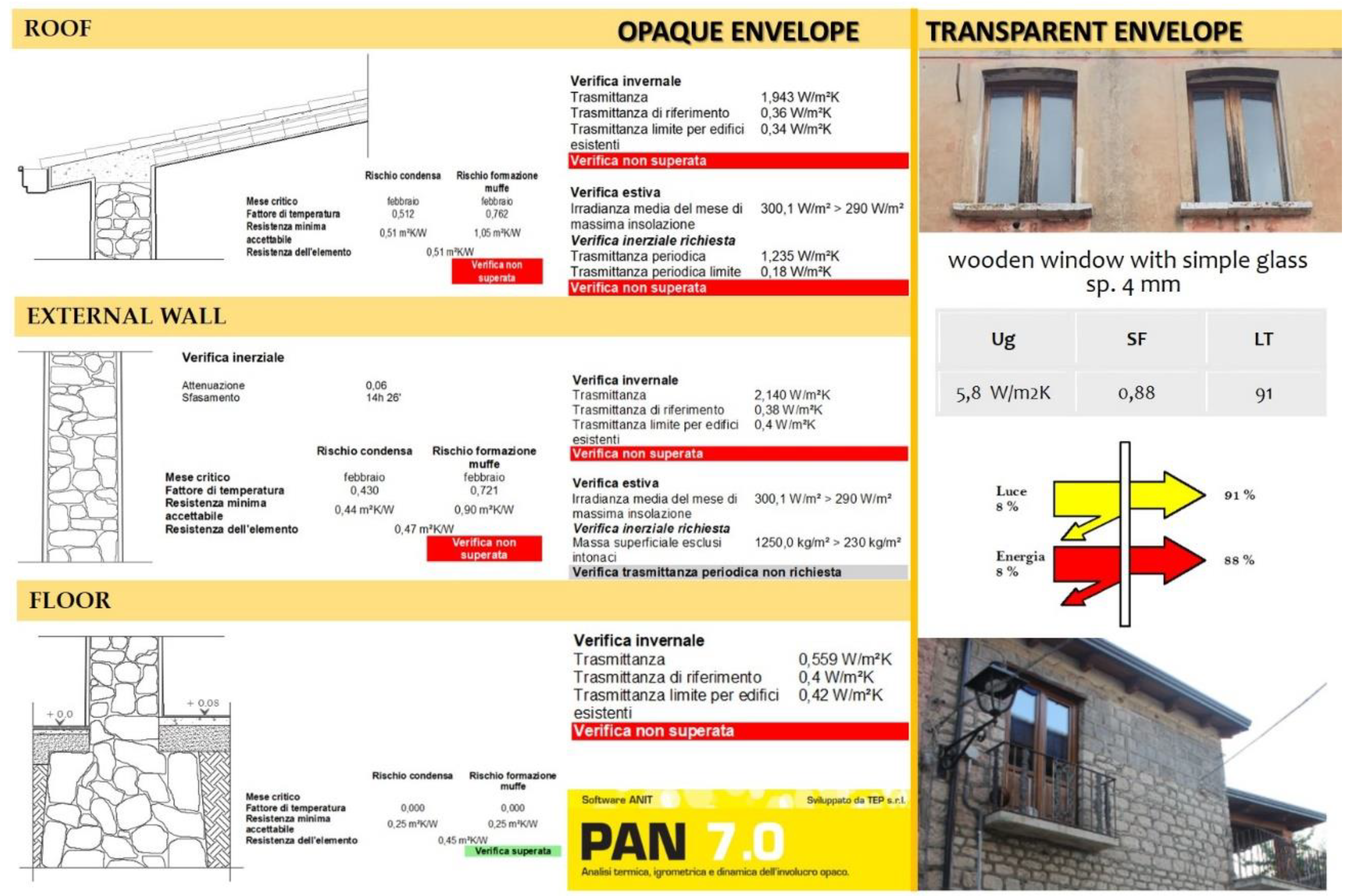

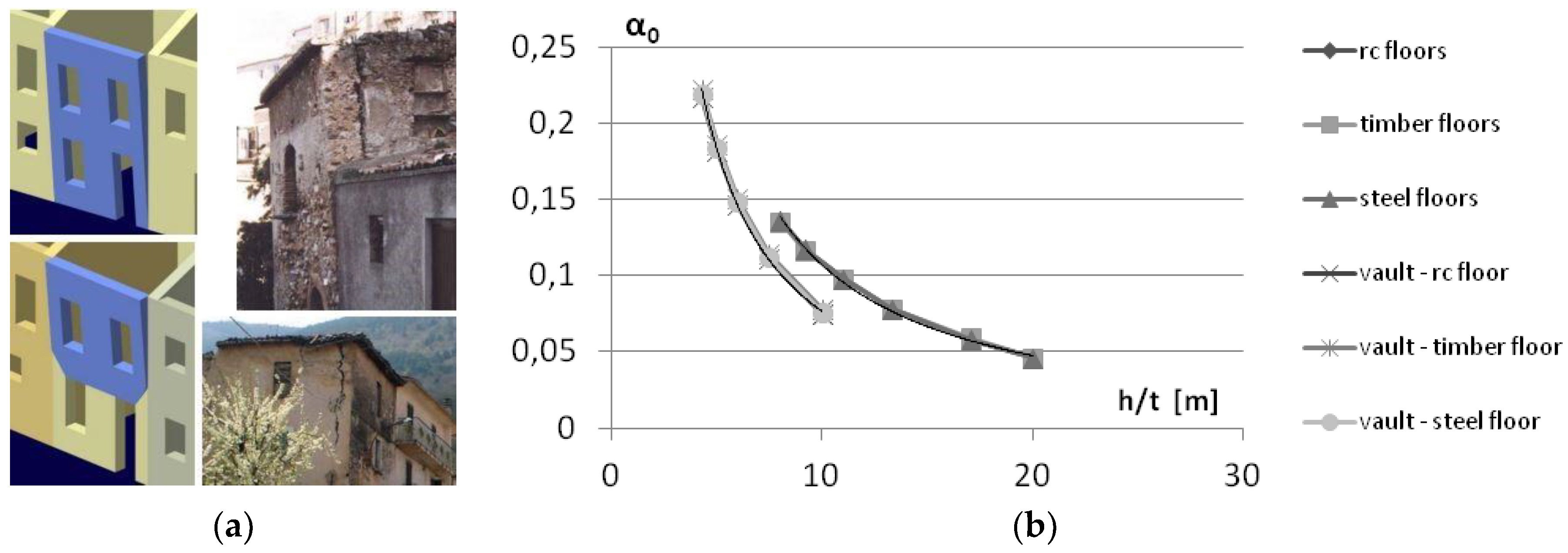


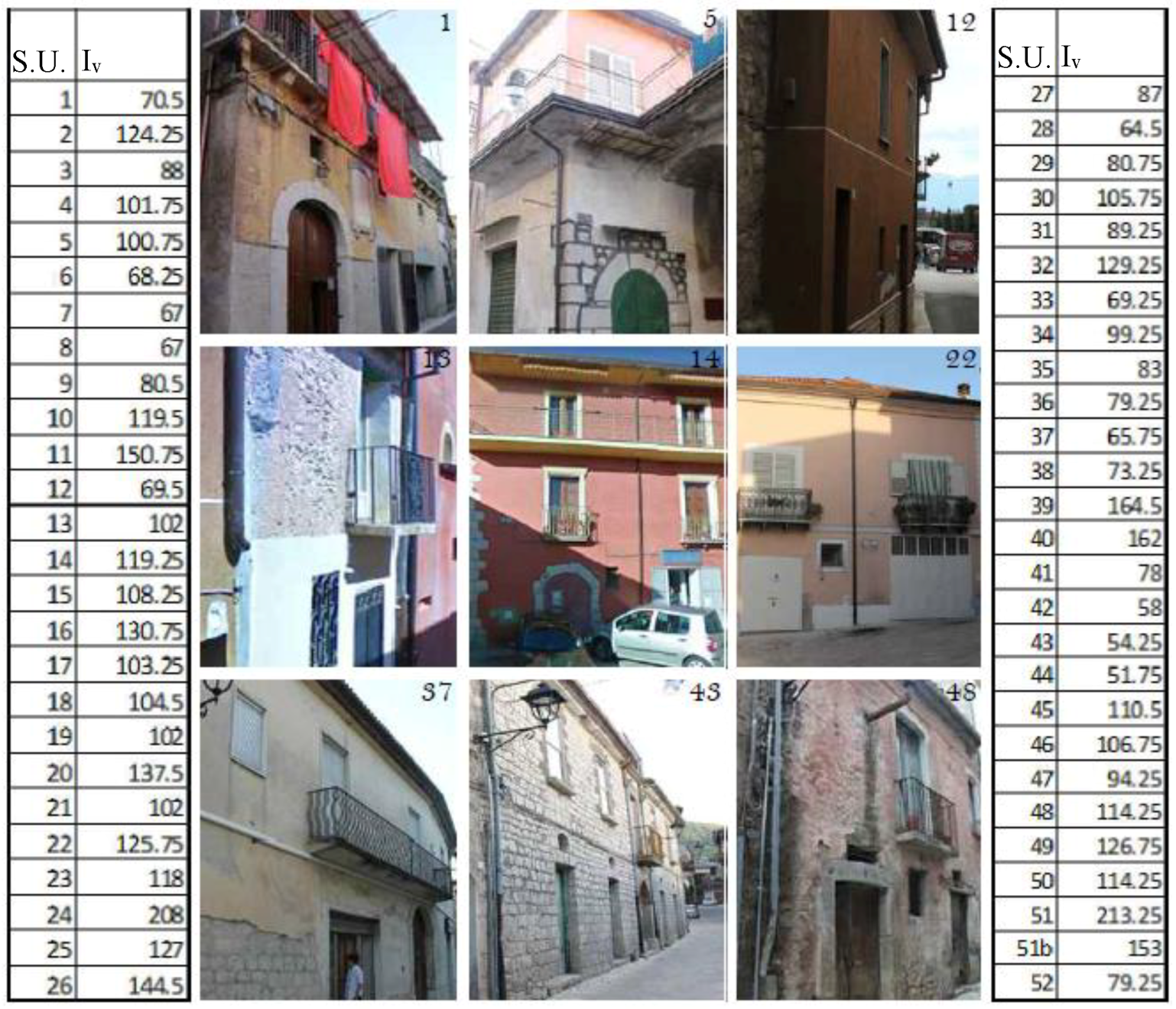


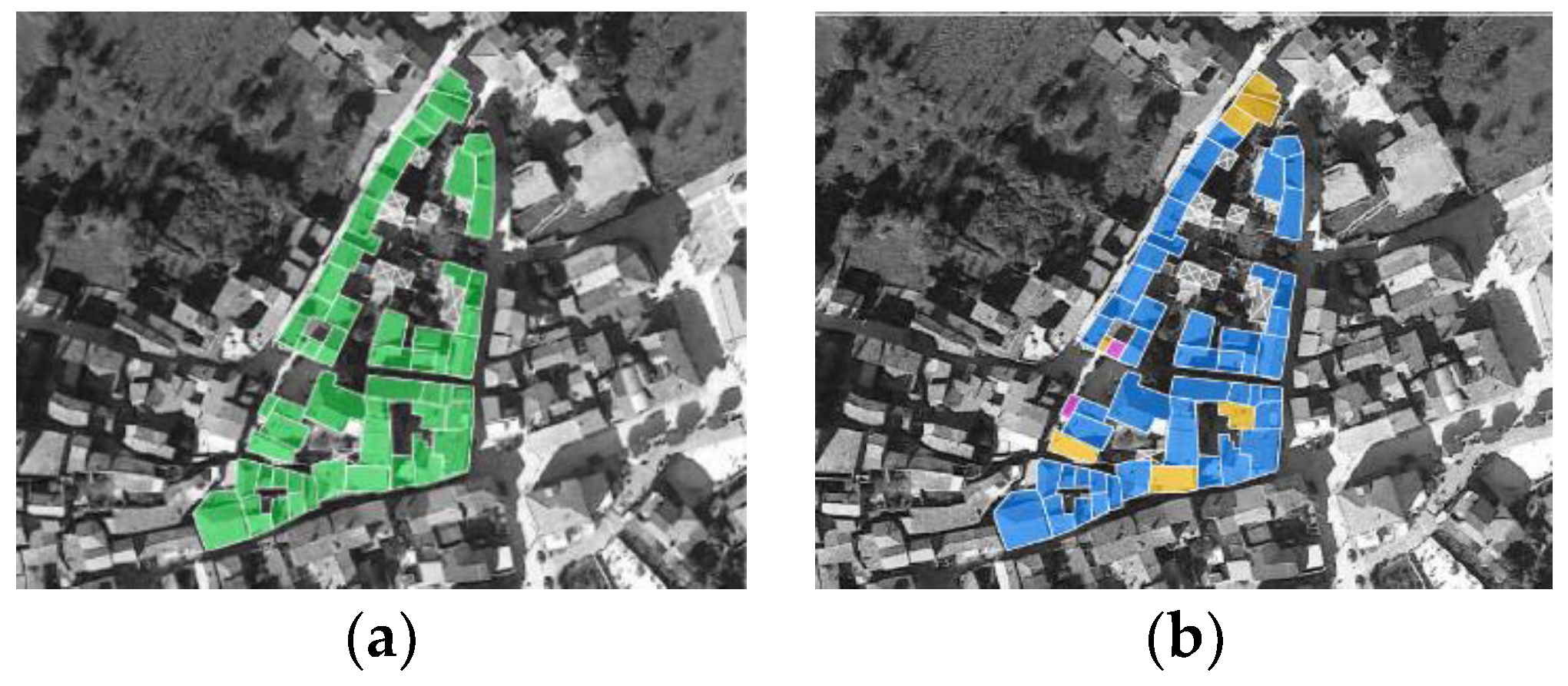

| Thermal Insulation | Transmittance | Periodic Transmittance | Attenuation | Thermal Phase Shift |
|---|---|---|---|---|
| Thickness: 10 cm | [W/m²K] | [W/m²K] | [n] | [h] |
| Without insulation | 2009 | 0.088 | 0.044 | 16 h 21′ |
| Stone wool panel (density 40 kg/m³) | 0.298 | 0.004 | 0.012 | 18 h 26′ |
| Wool glass panel (40 kg/m³) | 0.276 | 0.003 | 0.012 | 18 h 30′ |
| EPS S sintered expanded polystyrene panel (40 kg/m³) | 0.334 | 0.004 | 0.012 | 18 h 45′ |
| EPS S sintered expanded polystyrene panel with improved thermal conductivity through reduction of heat radiation transmission (30 kg/m3) | 0.283 | 0.003 | 0.012 | 18 h 30′ |
| PSE in slabs made from blocks (30 kg/m3) | 0.334 | 0.004 | 0.012 | 18 h 19′ |
| Parameter | Class Score (s) | Weight (w) | |||
|---|---|---|---|---|---|
| A | B | C | D | ||
| 1. Organization of vertical structures | 0 | 5 | 20 | 45 | 1 |
| 2. Nature of vertical structures | 0 | 5 | 25 | 45 | 0.25 |
| 3. Location of the building and type of foundation | 0 | 5 | 25 | 45 | 0.75 |
| 4. Distribution of plan resisting elements | 0 | 5 | 25 | 45 | 1.5 |
| 5. In-plane regularity | 0 | 5 | 25 | 45 | 0.5 |
| 6. Vertical regularity | 0 | 5 | 25 | 45 | 1 |
| 7. Type of floor | 0 | 5 | 15 | 45 | 1 |
| 8. Roofing | 0 | 15 | 25 | 45 | 0.75 |
| 9. Details | 0 | 0 | 25 | 45 | 0.25 |
| 10. Physical conditions | 0 | 5 | 25 | 45 | 1 |
| 11. Presence of adjacent buildings with different heights | −20 | 0 | 15 | 45 | 1 |
| 12. Position of the building in the aggregate | −45 | −25 | −15 | 0 | 1.5 |
| 13. Number of staggered floors | 0 | 15 | 25 | 45 | 0.5 |
| 14. Structural or typological heterogeneity among adjacent structural units | −15 | −10 | 0 | 45 | 1.2 |
| 15. Percentage difference of opening areas among adjacent facades | −20 | 0 | 25 | 45 | 1 |
 | |||||||
|---|---|---|---|---|---|---|---|
| S.U. | αo | PGA M = 4 | PGA M = 5 | PGA M = 6 | |||
| 1 | 0.301 | 0.209 | 0.284 | 0.386 | |||
| 2 | 0.261 | ||||||
| 3 | 0.301 | ||||||
| 4 | 0.261 | ||||||
| 5 | 0.301 | ||||||
| 6 | 0.301 | ||||||
| 7 | 0.339 | ||||||
| 8 | 0.339 | ||||||
| 9 | 0.301 | ||||||
| 10 | 0.301 | ||||||
| 11 | 0.261 | ||||||
| 12 | 0.301 | ||||||
| 13 | 0.301 | ||||||
| 14 | 0.261 | ||||||
| 15 | 0.261 | ||||||
| 16 | 0.261 | ||||||
| 17 | 0.261 | ||||||
| 18 | 0.261 | ||||||
| 19 | 0.261 | ||||||
| 20 | 0.261 | ||||||
| 21 | 0.261 | ||||||
| 22 | 0.301 | ||||||
| 23 | 0.261 | ||||||
| 24 | 0.261 | ||||||
| 25 | 0.261 | ||||||
| 26 | 0.301 | ||||||
| 27 | 0.339 | ||||||
| 28 | 0.339 | ||||||
| 29 | 0.261 | ||||||
| 30 | 0.261 | ||||||
| 31 | 0.261 | ||||||
| 32 | 0.261 | ||||||
| 33 | 0.301 | ||||||
| 34 | 0.301 | ||||||
| 35 | 0.301 | ||||||
| 36 | 0.301 | ||||||
| 37 | 0.301 | ||||||
| 38 | 0.301 | ||||||
| 39 | 0.261 | ||||||
| 40 | 0.261 | ||||||
| 41 | 0.301 | ||||||
| 42 | 0.301 | ||||||
| 43 | 0.301 | ||||||
| 44 | 0.301 | ||||||
| 45 | 0.301 | ||||||
| 46 | 0.261 | ||||||
| 47 | 0.301 | ||||||
| 48 | 0.301 | ||||||
| 49 | 0.301 | ||||||
| 50 | 0.261 | ||||||
| 51 | 0.261 | ||||||
| 51b | 0.261 | ||||||
| 52 | 0.301 | ||||||
© 2018 by the authors. Licensee MDPI, Basel, Switzerland. This article is an open access article distributed under the terms and conditions of the Creative Commons Attribution (CC BY) license (http://creativecommons.org/licenses/by/4.0/).
Share and Cite
Fumo, M.; Formisano, A.; Sibilio, G.; Violano, A. Energy and Seismic Recovering of Ancient Hamlets: the Case of Baia e Latina. Sustainability 2018, 10, 2831. https://doi.org/10.3390/su10082831
Fumo M, Formisano A, Sibilio G, Violano A. Energy and Seismic Recovering of Ancient Hamlets: the Case of Baia e Latina. Sustainability. 2018; 10(8):2831. https://doi.org/10.3390/su10082831
Chicago/Turabian StyleFumo, Marina, Antonio Formisano, Giulia Sibilio, and Antonella Violano. 2018. "Energy and Seismic Recovering of Ancient Hamlets: the Case of Baia e Latina" Sustainability 10, no. 8: 2831. https://doi.org/10.3390/su10082831






